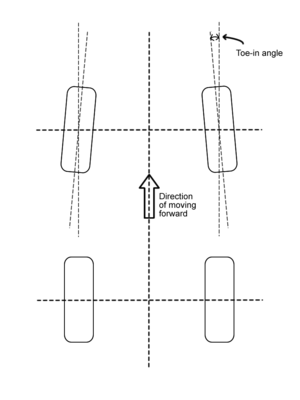
Back Sbíhavost kol Czech Spur- und Sturzeinstellung German Convergencia (automóvil) Spanish Aurauskulma Finnish Pincement (automobile) French Convergenza (veicoli) Italian Toespoor Dutch Spissing NB Zbieżność kół Polish Углы установки колёс Russian
This article needs additional citations for verification. (February 2011) |

In automotive engineering, toe, also known as tracking,[1] is the symmetric angle that each wheel makes with the longitudinal axis of the vehicle, as a function of static geometry, and kinematic and compliant effects. This can be contrasted with steer, which is the antisymmetric angle, i.e. both wheels point to the left or right, in parallel (roughly). Negative toe, or toe out, is the front of the wheel pointing away from the centreline of the vehicle. Positive toe, or toe in, is the front of the wheel pointing towards the centreline of the vehicle.[2] Historically, and still commonly in the United States, toe was specified as the linear difference (either inches or millimeters) of the distance between the two front-facing and rear-facing tire centerlines at the outer diameter and axle-height; since the toe angle in that case depends on the tire diameter, the linear dimension toe specification for a particular vehicle is for specified tires.[3]
- ^ "Beardmore Bros How To Do Tracking". beardmorebros.co.uk. Retrieved 20 February 2011.
Now adjust the tracking
- ^ "Toe-out and Handling, steering geometry & front end alignment". auto-ware.com. Retrieved 28 August 2011.
- ^ "Wheel Alignment: a Short Course".
© MMXXIII Rich X Search. We shall prevail. All rights reserved. Rich X Search